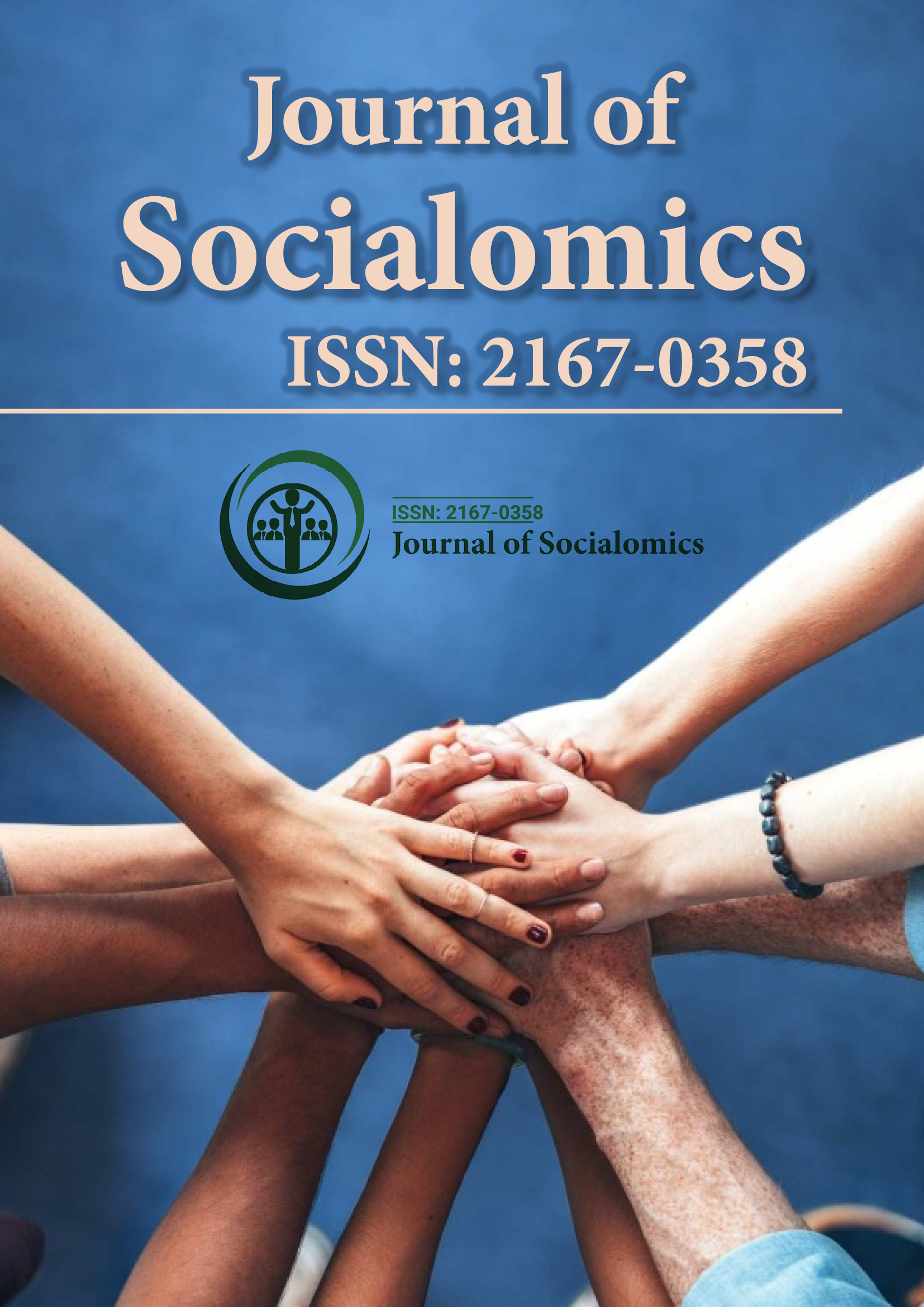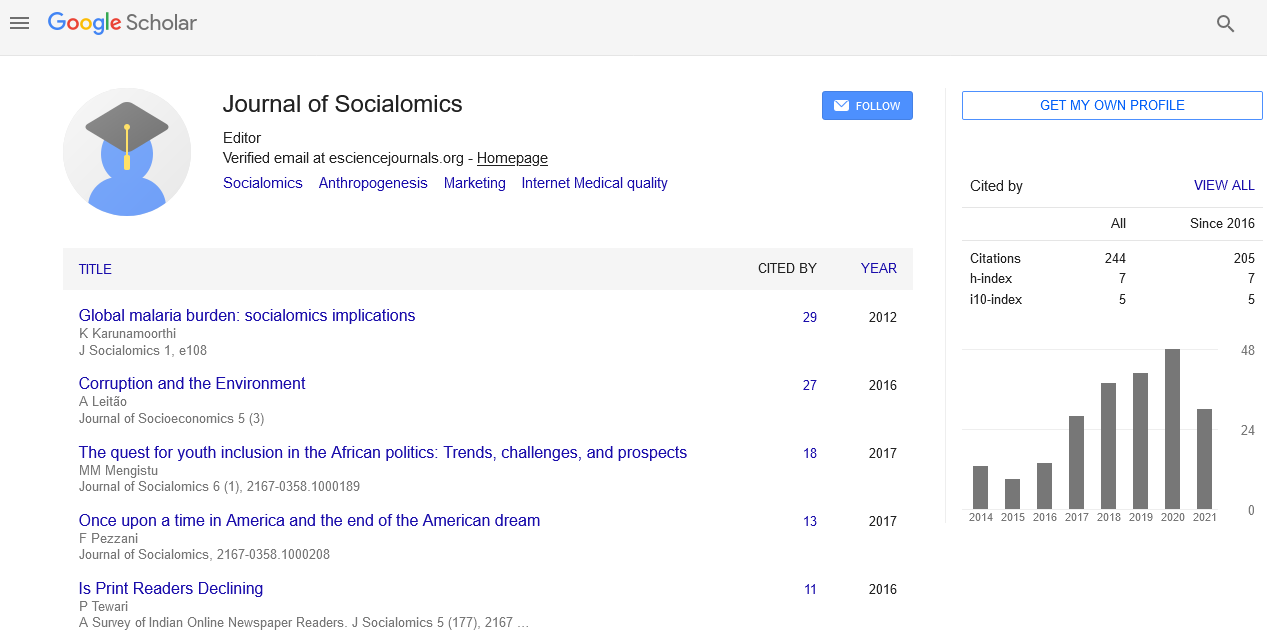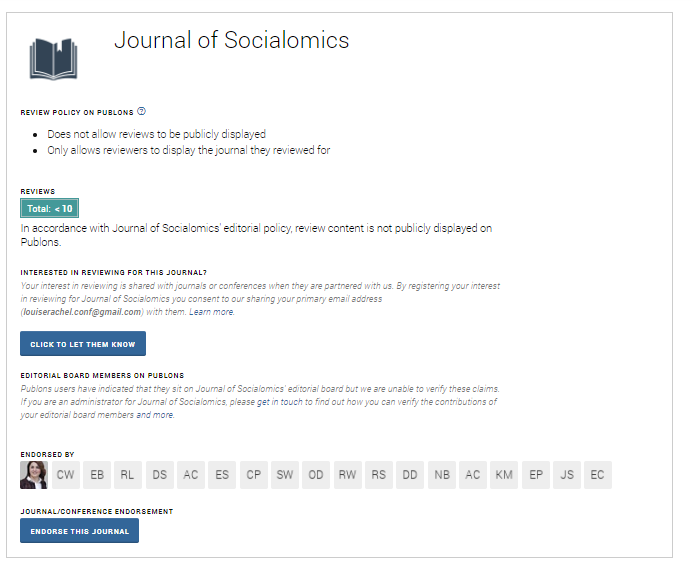Indexed In
- Open J Gate
- Genamics JournalSeek
- SafetyLit
- RefSeek
- Hamdard University
- EBSCO A-Z
- OCLC- WorldCat
- Publons
- Google Scholar
Useful Links
Share This Page
Journal Flyer

Open Access Journals
- Agri and Aquaculture
- Biochemistry
- Bioinformatics & Systems Biology
- Business & Management
- Chemistry
- Clinical Sciences
- Engineering
- Food & Nutrition
- General Science
- Genetics & Molecular Biology
- Immunology & Microbiology
- Medical Sciences
- Neuroscience & Psychology
- Nursing & Health Care
- Pharmaceutical Sciences
Short Communication - (2025) Volume 14, Issue 2
Social Influence and Peer Dynamics in Online Micro-Communities
Elena Navarro*Received: 26-May-2025, Manuscript No. JSC-25-29728; Editor assigned: 28-May-2025, Pre QC No. JSC-25-29728; Reviewed: 11-Jun-2025, QC No. JSC-25-29728; Revised: 18-Jun-2025, Manuscript No. JSC-25-29728; Published: 25-Jun-2025, DOI: 10.35248/2167-0358.25.14.275
Description
Online spaces have become increasingly central to social interactions, yet the influence of peer dynamics in tightly knit digital groups remains underexplored. These micro-communities, often built around shared interests or identities, are typically perceived as casual extensions of daily life. However, they function as powerful agents of social shaping. Discussions, beliefs, and behaviors within these digital clusters often reflect deeply internalized group values. Unlike traditional offline communities, these spaces allow for near-constant engagement, creating a feedback loop that strengthens consensus and resistance to alternative views. This dynamic produces both inclusion and exclusion, with conformity frequently being rewarded through social approval mechanisms such as likes, reposts, and private endorsements.
The structures of these communities often operate with informal hierarchies. Users with higher engagement or longer tenure can shape conversations in subtle and overt ways. They become reference points for group norms, even without formal authority. Others align their opinions and tone accordingly, creating an environment where deviation may lead to social penalties. This peer-driven enforcement serves as a method of group control, but unlike top-down moderation, it can be unpredictable and emotionally charged [1-4]. Members often internalize the behavioral expectations, modifying their language and actions to remain in good standing. This leads to significant behavioral alignment that can echo offline, particularly when these groups overlap with personal or professional relationships.
Identity presentation in these spaces is another area shaped by peer influence. Users adapt their self-descriptions, opinions, and even their visual content to align with perceived group preferences. While it could be argued that this reflects simple adaptation, the sustained alignment over time indicates deeper shifts in selfperception. Identity within such micro-communities becomes curated not only for belonging but for influence. Individuals seek validation not only by conforming but also by strategically deviating in ways that are deemed acceptable or performative. The line between authenticity and performative identity becomes blurred, leading many to question how much of their digital persona reflects their offline reality.
Moreover, content circulation within these circles provides further insight into peer influence. Posts that gain popularity often reflect a tone or subject matter already accepted by the group. Originality tends to be rewarded when it falls within existing frameworks, while dissent is met with silence or overt criticism. This environment discourages outlier perspectives, particularly from newer members or those who differ significantly in background. As a result, content homogeneity is both a product and a reinforcement of peer dynamics. While on the surface this can appear as cohesion, it masks deeper issues related to groupthink and insularity. Over time, this can limit exposure to alternative viewpoints and contribute to polarization [5-8].
Observational data and user interviews reveal that emotional response plays a significant role in shaping interactions within micro-communities. Positive emotions such as validation, amusement, and empathy are more likely to be shared and rewarded, while expressions of skepticism, criticism, or disagreement are often softened or suppressed. This leads to a skewed emotional atmosphere, where users feel compelled to maintain a certain tone. Emotional alignment becomes another vector of influence, shaping not just what is said but how it is said. Some users even report anxiety around posting, citing the unpredictable response of their peers as a reason for selfcensorship [9-10].
Despite their informal nature, these communities carry real social consequences. Professional opportunities, personal relationships, and even mental health are increasingly linked to digital reputation and perceived alignment with group standards. The lines between digital and physical spaces continue to blur, and the behaviors shaped in one often transfer to the other. The feedback mechanisms within micro-communities create not only short-term shifts but long-term behavioral conditioning. What begins as mere participation can evolve into significant selfmodification, often without conscious recognition.
Conclusion
Further research into these spaces is necessary, particularly in examining how peer dynamics influence marginalized voices, reinforce biases, or provide alternative spaces for identity development. As online communities continue to fragment into more specific and insular groups, the social influence they exert may become even more pronounced. These dynamics deserve attention not because they are new, but because they occur in spaces where many still believe their behavior is less consequential. Understanding these peer dynamics offers a chance to better comprehend how modern identity is coconstructed in digital life.
References
- Cao W, Chen HD, Yu YW, Li N, Chen WQ. Changing profiles of cancer burden worldwide and in China: A secondary analysis of the global cancer statistics 2020. Chin Med J (Engl). 2021;134(07):783-791.
[Crossref] [Google Scholar] [PubMed]
- Mirzaei S, Ghodsi R, Hadizadeh F, Sahebkar A. 3Dâ?Quantitative Structure-Activity Relationship (QSAR)â?based pharmacophore modeling, virtual screening and molecular docking studies for identification of tubulin inhibitors with potential anticancer activity. Biomed Res Int. 2021;2021(1):6480804.
[Crossref] [Google Scholar] [PubMed]
- Binarova P, Tuszynski J. Tubulin: Structure, functions and roles in disease. Cells. 2019;8(10):1294.
[Crossref] [Google Scholar] [PubMed]
- Lacroix B, Dumont J. Spatial and temporal scaling of microtubules and mitotic spindles. Cells. 2022;11(2):248.
[Crossref] [Google Scholar] [PubMed]
- Battaje RR, Panda D. Lessons from bacterial homolog of tubulin, FtsZ for microtubule dynamics. Endocr Relat Cancer. 2017;24(9):01-21.
[Crossref] [Google Scholar] [PubMed]
- El-Saber Batiha G, Alqahtani A, Ilesanmi OB, Saati AA, El-Mleeh A, Hetta HF, et al. Avermectin derivatives, pharmacokinetics, therapeutic and toxic dosages, mechanism of action and their biological effects. Pharmaceuticals. 2020;13(8):196.
[Crossref] [Google Scholar] [PubMed]
- Campbell W. History of avermectin and ivermectin, with notes on the history of other macrocyclic lactone antiparasitic agents. Curr Pharm Biotechnol. 2012;13(6):853-865.
[Crossref] [Google Scholar] [PubMed]
- Zhang Q, Bai P, Zheng C, Cheng Y, Wang T, Lu X. Design, synthesis, insecticidal activity and molecular docking of doramectin derivatives. Bioorg Med Chem. 2019;27(12):2387-2396.
[Crossref] [Google Scholar] [PubMed]
- Dominguezâ??Gomez G, Chavezâ??Blanco A, Medinaâ??Franco JL, Saldivarâ??Gonzalez F, Floresâ??Torrontegui Y, Juarez M, et al. Ivermectin as an inhibitor of cancer stemâ??like cells. Mol Med Rep. 2018;17(2):3397-3403.
[Crossref] [Google Scholar] [PubMed]
- Dou Q, Chen HN, Wang K, Yuan K, Lei Y, Li K, et al. Ivermectin induces cytostatic autophagy by blocking the PAK1/Akt axis in breast cancer. Cancer Res. 2016;76(15):4457-4469.
[Crossref] [Google Scholar] [PubMed]
Citation: Navarro E (2025). Social Influence and Peer Dynamics in Online Micro-Communities. J Socialomics. 14:275.
Copyright: © 2025 Navarro E. This is an open-access article distributed under the terms of the Creative Commons Attribution License, which permits unrestricted use, distribution and reproduction in any medium, provided the original author and source are credited.


